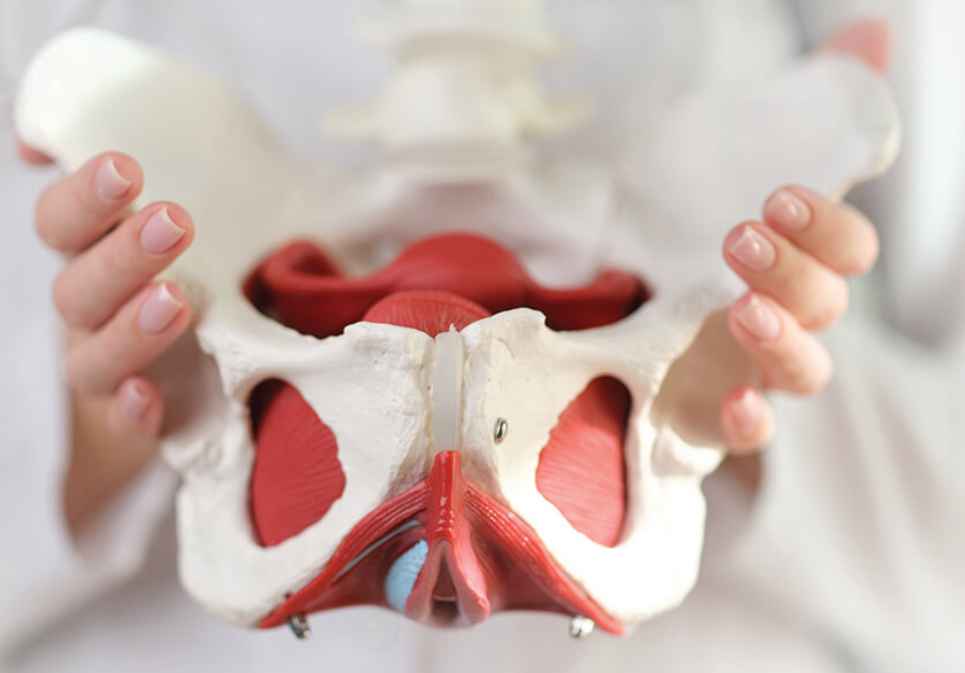
Ladies, let’s face it: if you’re ready to enjoy a romantic evening, but instead find yourself wincing in pain, know that you’re not alone—but you also don’t have to just accept it. Painful sex isn’t a quirky part of being a woman; it’s your body’s way of saying, “Hey, my pelvic floor needs some love.” Imagine being able to swap discomfort for delight—pelvic floor physical therapy can help you do exactly that.
Think of it as hitting the reset button on your intimate life. With specialized techniques and personalized care, pelvic floor physical therapy can help you move from merely enduring pain to fully embracing pleasure. It’s time to normalize the conversation about sexual health and reclaim the joy and connection that intimacy should bring.
What Causes Painful Sex?
There are several culprits behind painful sex, and understanding them is the first step toward relief:
- Tight or Overactive Pelvic Floor Muscles: Chronic tension in the pelvic area isn’t just about a stiff back—when those muscles are too tight or overactive, they can make every movement, especially intimacy, uncomfortable.
- Pelvic Floor Dysfunction: Conditions like vaginismus or vulvodynia indicate that the pelvic floor muscles or nerves aren’t functioning as they should, leading to spasms, pain, or both during sex.
- Hormonal Changes: Life’s big transitions—menopause, postpartum shifts, and even the effects of certain birth control methods—can impact vaginal health and alter muscle tone, sometimes leaving you in discomfort.
- Underlying Medical Conditions: Issues like endometriosis and PCOS can create an inflammatory environment or structural changes that contribute to painful sex.
- Trauma, Stress, and Emotional Factors: Our minds and bodies are connected, and physical or emotional trauma can trigger chronic muscle tension in the pelvic region, compounding the problem.
How Pelvic Floor Physical Therapy Can Help Painful Sex

Pelvic floor physical therapy is much more than a quick fix—it’s a comprehensive, individualized approach designed to transform how your pelvic muscles function and, ultimately, how you experience intimacy. Rather than simply masking the pain, pelvic floor PT addresses the root causes of discomfort, whether they stem from muscle tightness, weakness, or poor coordination. Here’s a deeper dive into the various ways pelvic floor PT can make a real difference in your sexual health and overall well-being:
1. Comprehensive Assessment and Diagnosis
Before treatment begins, your pelvic floor PT will perform a detailed evaluation that goes beyond a basic physical exam. This assessment may include:
- Muscle Tone and Coordination Analysis: Using manual techniques and sometimes neuromuscular retraining, your therapist will gauge the strength, flexibility, and responsiveness of the pelvic muscles.
- Postural and Movement Observations: They’ll observe how you move and hold your body, as subtle changes in posture or muscle imbalances can contribute to pelvic discomfort.
- History & Symptom Discussion: Understanding your personal history—ranging from childbirth and surgery to hormonal shifts and emotional stress—helps your therapist tailor the treatment to your specific needs.
2. Targeted Relaxation and Strengthening Techniques
Once a diagnosis is made, your PT will craft a customized treatment plan that often includes a mix of exercises designed to both relax tight muscles and strengthen weak ones.
- Relaxation Techniques: Often, pelvic pain is linked to overactive muscles. Techniques such as deep breathing, progressive muscle relaxation, and guided imagery can help release tension and lower stress levels, making it easier to counteract chronic tightness.
- Strengthening Exercises: Not all pelvic floor issues are about looseness—some women need to strengthen their pelvic muscles to better support the pelvic organs. Guided exercises focus on proper muscle recruitment, often incorporating techniques that also engage the deep abdominal muscles and back for enhanced core stability.
- Neuromuscular Re-Training: This process involves training the brain and nerves to communicate more effectively with your pelvic floor. This re-training helps ensure that you can control the muscles during activities like intimacy, reducing pain by improving muscle response and coordination.
3. Manual Therapy and Hands-On Techniques
Physical therapists are trained in manual therapy—a hands-on approach that can quickly reduce pain and improve mobility. This might involve:
- Myofascial Release: Targeting trigger points in the pelvic region, this gentle massage technique can help break up tension and improve blood flow.
- Internal and External Soft Tissue Techniques: Depending on your comfort and specific issues, your therapist might work internally or externally to loosen scar tissue, decrease muscle spasm, and enhance muscle elasticity.
- Trigger Point Therapy: Applying pressure to specific points that refer pain can provide immediate relief and help retrain the pelvic muscles to relax properly.
- Visceral Mobilizations – Bladder and Uterus:
A gentle hands-on technique that helps restore mobility and balance to internal organs like the bladder and uterus. By releasing restrictions around these structures, this method can improve pelvic alignment, reduce pressure or discomfort, and enhance organ function. - Diaphragm and Rib Mobilizations: Focused on improving movement and function in the diaphragm and rib cage, these techniques support better breathing mechanics, core stability, and pressure regulation in the abdomen and pelvic floor. Releasing tension here can ease pelvic symptoms, improve posture, and enhance overall mobility.
4. Lifestyle and Behavioral Modifications
Pelvic floor PT isn’t confined to the treatment room—it extends into your everyday habits. Your therapist will offer guidance on lifestyle adjustments that support pelvic health:
- Stress Management: Recognizing the link between stress and pelvic tension, therapists might recommend practices such as meditation or yoga to create a calmer, more balanced nervous system. Read HERE for more on stress management.
- Diet and Hydration: Proper hydration and a balanced diet can influence tissue health and reduce inflammation. Even recommendations on how and when to eat can make a difference in how your body handles muscle recovery. Read HERE for more on hydration.
- Sleep and Movement Habits: Often overlooked, the quality of your sleep and your daily movement routine play a role in managing chronic pain. Your PT may offer tips for optimizing sleep positions or integrating short, effective stretching sessions into your daily routine.
5. Customized Home Exercise Programs
One of the most empowering aspects of pelvic floor PT is the creation of a home exercise program tailored to your unique needs. These programs might include:
- Breathing Exercises: Focusing on diaphragmatic breathing to help relax the pelvic muscles and reduce involuntary tension.
- Core and Pelvic Floor Activation: Specific exercises to promote better coordination between your core and pelvic floor, ensuring that both systems work in harmony during activities—and intimacy.
- Stretching Routines: Gentle stretches that improve pelvic mobility and flexibility, reducing the discomfort that tight muscles can cause.
6. Continuous Monitoring and Adjustments
Recovery and improvement are dynamic processes. A pelvic floor PT will monitor your progress over time, adjusting the treatment plan as needed. This continuous feedback loop means that treatments are always evolving—ensuring that you’re not only seeing improvements in your symptoms but also learning techniques to maintain those gains for the long haul.
At its core, pelvic floor physical therapy is a collaborative process. It’s about empowering you with the tools, exercises, and lifestyle changes needed to regain control and comfort in your intimate life. With the right approach, painful sex doesn’t have to be an accepted norm—you deserve to experience pleasure without pain, and pelvic floor PT is here to help make that possible.
Definite Signs You Should See a Pelvic Floor Physical Therapist
While everyone might experience an off night occasionally, persistent issues are a clear sign that professional help could make a big difference:
- If you consistently feel pain during penetration (whether during intercourse, when inserting tampons, or even during routine exams), it’s time to get a professional evaluation.
- A persistent feeling of tightness or burning in your pelvic area—especially if it’s affecting your mood and your sex life—warrants attention.
- Postpartum changes or the transition through menopause can bring unique challenges to your sexual health; if these changes leave you in discomfort, don’t hesitate to seek help.
- Chronic pelvic pain that lingers beyond the bedroom and disrupts your daily life is not something you should simply “manage” on your own.
If you have some of these symptoms and maybe some others that you’re wondering about- check out this post about other symptoms warranting a pelvic floor physical therapist.
Don’t Suffer in Silence

Painful sex isn’t just a rite of passage—it’s a treatable condition. You deserve to enjoy every moment of intimacy without pain, and the right help is closer than you think. At Mitchell Holistic Health, our dedicated pelvic floor PT, Cassidy, is here to help you understand your body, address underlying issues, and restore comfort and confidence in your intimate relationships.
Don’t suffer in silence. Explore the possibility of a happier, pain-free sex life by contacting us today here at Mitchell Holistic Health treating clients in the Onalaska and LaCrosse areas and starting your journey toward healing. Remember, you’re not alone, and relief is within reach!
5 FAQs addressing painful sex and pelvic floor health:
1. What exactly is dyspareunia, and how do I know if my pain qualifies
Dyspareunia refers to persistent or recurrent pain during sexual intercourse. It’s important to note that while occasional discomfort may occur, chronic or severe pain isn’t normal. If you experience consistent or worsening pain, it might be classified as dyspareunia and warrants a professional evaluation.
2. Are there any risks or side effects associated with pelvic floor physical therapy?
Pelvic floor PT is generally safe when provided by a certified professional. Some patients may experience temporary discomfort or mild soreness as their muscles adjust to new exercises and techniques; however, severe pain is uncommon and should be discussed with your therapist immediately.
3. Can pelvic floor PT be used alongside other treatments, like medications or surgical interventions?
Yes, pelvic floor PT can complement other treatments for pelvic pain or dysfunction. Whether you’re on medications or considering surgical options, PT can often be an integral part of a comprehensive treatment plan—always coordinated with your healthcare provider.
4. How do lifestyle factors like stress, diet, and sleep impact pelvic floor health?
Stress, poor diet, and inadequate sleep can significantly affect muscle tension and inflammation, including in the pelvic floor. Pelvic floor PT often includes lifestyle and behavioral recommendations—such as stress management techniques, nutritional guidance, and sleep hygiene—to support overall healing and reduce pain.
5. Beyond painful sex, what other conditions can pelvic floor PT help improve?
Pelvic floor PT isn’t just for treating dyspareunia. It can also help manage urinary incontinence, chronic pelvic pain, vaginismus, and issues related to postpartum or menopausal changes. By restoring balance in pelvic muscle function, it can enhance overall quality of life and comfort.


